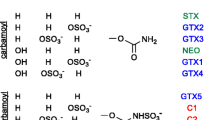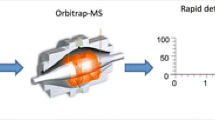Abstract
A European interlaboratory collaborative study was conducted to validate a method for the quantitative determination of lipophilic marine biotoxins based on high-performance liquid chromatography–tandem mass spectrometry. During this study, the diarrhetic shellfish poisoning toxins okadaic acid, dinophysis toxin1 and 2 including their esters, the azaspiracids 1-3, pectenotoxin2, and the yessotoxins were investigated at concentration levels near the limit of quantification and near the legal limit. Naturally contaminated blue mussels, both raw and cooked and spiked extracts of clams and oysters were studied and results were obtained for 16 test samples from 16 laboratories representing eight different countries. This article summarizes the study outcome concerning validation key parameters like specificity, linearity, limit of detection, accuracy/recovery, and precision. Further, influences of cooking of mussels before homogenization or hydrolysis on method robustness have been evaluated.


Similar content being viewed by others
References
European Union (2004) Brussels. Off J Eur Union L 226:22
EFSA (2008) EFSA J 589:1–62
EFSA (2008) EFSA J 723:1–52
EFSA (2008) EFSA J 907:1–62
EFSA (2009) EFSA J 1109:1–47
European Union (2005) Brussels. Off J Eur Union L 338:27
McNabb P, Selwood AI, Holland PT (2005) J AOAC Int 88:761–772
European Union. (EC) No 854/2004
Horwitz W (1995) Pure Appl Chem 67:331–343
Mountfort DO, Suzuki T, Truman P (2000) Toxicon 39:383–390
Thompson M, Wood R (1993) J AOAC Int 76:926–940
Horwitz W, Kamps LR, Boyer KW (1980) J Assoc Off Anal Chem 63:1344–1354
ISO 11843: Capability of detection, June 2006. 2010
ISO 5725-3. (including Technical Corrigendum). 2001
Thompson M (2000) Analyst 125:385–386
Careri M, Mangia A (2006) Anal Bioanal Chem 386:38–45
Fux E, Rode D, Bire R, Hess P (2008) Food Addit Contam 25:1024–1032
Gerssen A, McElhinney MA, Mulder PPJ, Bire R, Hess P, de Boer J (2009) Anal Bioanal Chem 394:1213–1226
These A, Scholz J, Preiss-Weigert A (2009) J Chromatogr A 1216:4529–4538
Hess P, Nguyen L, Aasen J, Keogh M, Kilcoyne J, McCarron P, Aune T (2005) Toxicon 46:62–71
Rodrigues SM, Vale P, Botelho MJ, and Gomes SS (2009) Food Additives and Contaminants Part A—Chemistry Analysis Control Exposure & Risk Assessment 26:229-235
Lee JS, Yanagi T, Kenma R, Yasumoto T (1987) Agric Biol Chem 51:877–881
Gerssen A, van Olst EHW, Mulder PPJ, de Boer J (2010) Anal Bioanal Chem 397:3079–3088
Acknowledgment
We thank Margarete Schramm for her careful organization of the laboratory work, especially the skilful preparation of samples and calibrants. Furthermore, we thank the competent agencies, the National Reference Laboratories of Norway and Ireland, for having kindly provided contaminated samples for analytical purposes.
Author information
Authors and Affiliations
Corresponding author
Additional information
Collaborators: Z. Amzil, M. Baden, C. Duffy, S. Effkemann, F. Gassmann, L. Heinze, P. Hess, G. Hochreuther, W. Hoebel, A. Johansson, K. Jorgensen, R. Kelly, O. Keuth, I. Lange, B. Luckas, A. Milandri, A. Miller, S. Morris, A.Z. Muratovic, I. Nausch, S. O´Brian, S. Pigozzi, P. Resch, K. Soellner, M.L. Rodriguez Velasco, M. Schramm, U. Schwank, M. Sibat, G. Thielert, C. Wiedow
Rights and permissions
About this article
Cite this article
These, A., Klemm, C., Nausch, I. et al. Results of a European interlaboratory method validation study for the quantitative determination of lipophilic marine biotoxins in raw and cooked shellfish based on high-performance liquid chromatography–tandem mass spectrometry. Part I: collaborative study. Anal Bioanal Chem 399, 1245–1256 (2011). https://doi.org/10.1007/s00216-010-4383-3
Received:
Revised:
Accepted:
Published:
Issue Date:
DOI: https://doi.org/10.1007/s00216-010-4383-3




